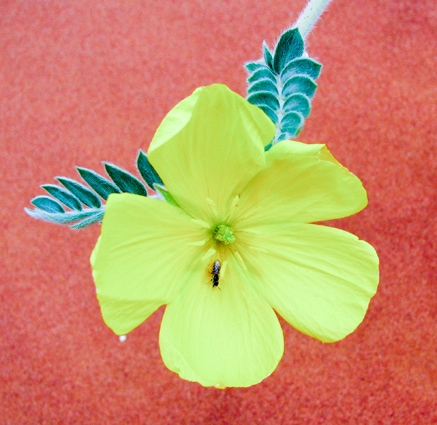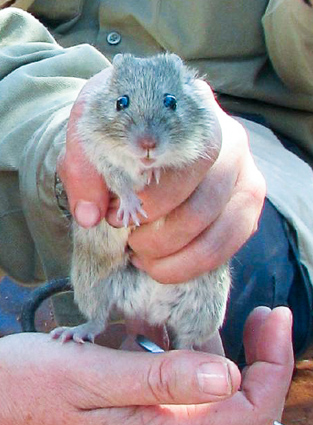Researchers measuring a long-haired rat (Rattus villosissimus) as part of studies at the Desert Ecology Plot Network (Photo courtesy of Glenda Wardle)
Australia’s arid zone is a highly unpredictable environment, characterised by extremes of temperature and rainfall. It is in this setting that you will find the Desert Ecology Plot Network, part of TERN’s Long-Term Ecological Research Network, located in the Simpson Desert in south-western Queensland.
Although average annual rainfall for the area is recorded as 200 mm, averages are a poor indicator of what actually occurs in this environment. Typically there are prolonged periods of drought episodically interrupted by intense rainfall events, resulting in a boom–bust pattern. A team of researchers led by Professor Chris Dickman* and Associate Professor Glenda Wardle at the University of Sydney has been working to understand the patterns and processes at work in this environment for over 20 years.
The boom-and-bust nature of the Simpson Desert is well demonstrated by the case of the Australian long-haired rat (Rattus villosissimus). Distributed throughout central Australia, this species is largely absent during dry periods, surviving by seeking refuge in small, moist areas that offer shelter and food. However, following heavy rains the population can irrupt, bursting suddenly into plague proportions.
‘These rodent plague events are so notable that they appear in the historic records and we are also fortunate to have directly witnessed two events in our long-term datasets,’ says Glenda.
The most recent plague occurred over 2010–2011, providing Aaron Greenville with the opportunity to investigate the irruption and invasion dynamics of the long-haired rat. Aaron is a PhD student working under the supervision of Chris and Glenda**.
‘It was exciting to witness such a rare event as a long-haired rat irruption, and this research helps us understand how extreme weather events, such as flooding rainfalls, affect populations,’ Aaron says. He collected live trapping data in the Desert Ecology Plot Network, and was also able to access data from an irruption in 1991 for his analysis. When combined with a range of historical records that spanned a century, Aaron was able to examine a number of parameters related to the irruption of long-haired rats in the Simpson Desert.
Aaron’s findings confirm the importance of rainfall for stimulating an irruption, with an 80% chance of a plague occurring after annual rainfall of 750 mm or more. His findings also demonstrate the rapid rate of population irruption, with colonisation of sampled sites occurring within a month. In addition, the patterns observed throughout the study suggest that the long-haired rat irrupts from multiple refugia, not a single location as previous studies had suggested.
The example of the long-haired rat highlights the significance of long-term ecological studies, like those at the Desert Ecology Plot Network, for understanding patterns and processes that occur in this highly variable environment.
‘As these extreme events are predicted to increase due to climate change, this research provides a hint as to how the desert system is likely to respond,’ Aaron says.
Understanding responses to environmental cues is a theme that underpins much of the research at the Desert Ecology Plot Network. Another example is studies of flower–visitor interactions. Globally, much research has focussed on the response of individual species or groups to climate variables, but fewer studies have examined the ways that a changing climate could affect the interactions between species. Studies at the Desert Ecology Plot Network are helping to document the networks that arise from interactions between flowering plant species and insect pollinators.
Glenda says: ‘Global declines in pollinators have grabbed our attention but here in Australia but we are still in the early stages of documenting the vast diversity of native bees and wasps and their contribution to sustaining plant reproduction.’
The team is also examining the variations in these interactions over time, space, and in response to changing environmental factors***. Through this work researchers, including PhD student Tony Popic, have recorded the diversity of interactions between flowering plants and insects that occur within the Desert Ecology Plot Network****. They’ve also noted how these interactions vary over space and time. Tony says: ‘Understanding the diversity of species that interact in flower–visitor interactions has turned out to be a task greater than many of us expected. New species are popping up everywhere! Contrasting to other parts of Australia and the globe, where people are trying to document and understand the rates and repercussions of pollinator declines, we’re trying to understand how such diversity fits together in interaction networks, and what this means for the persistence of species and pollination as an ecosystem service.’
Strengthening understanding of ecological interactions and processes such as these could ultimately help to predict how they will respond to change and inform management strategies for the future.
‘Our surveys of the networks of interactions among plants and the invertebrates that visit their flowers provide a baseline against which we can monitor future climate-driven changes,’ says Glenda.
Given the importance of pollination as an ecosystem service in agriculture, this work could also be of relevance in a wider context.
The long-term studies undertaken at the Desert Ecology Plot Network will feature, along with other LTERN research, in a forthcoming book from TERN’s Multi-Scale Plot Network on monitoring environmental change. It will be published by CSIRO in mid-2013, and aims to be a data-rich book that demonstrates the value and integration of existing national long-term ecological research in Australia for monitoring environmental change and informing natural resource management.

An insect visiting a flower of Tribulus terrestris. Researchers at the Desert
Ecology Plot Network record interactions between insects and flowers such as
this in order to better understand how these interactions may be influenced
by changing environmental factors. (Photo courtesy of Glenda Wardle)
*Chris Dickman will be a keynote speaker at this year’s Australasian Wildlife Management Society conference, 27–29 November in Adelaide.
**This work is funded by an ARC grant to Chris Dickman and Glenda Wardle, and the LTERN Desert Ecology Plot Network. The research quoted here comes from a journal paper currently in review. For more information please email Aaron Greenville.
***Glenda, Tony and Yvonne Davila will present their work at a symposium, ‘Plant pollination and mate choice’, at the Ecological Society of Australia’s annual conference, 3–7 December in Melbourne.
****This is work from Tony Popic’s PhD, supervised by Glenda Wardle and Yvonne Davila. It is funded by an ARC grant to Chris Dickman and Glenda Wardle, and the LTERN Desert Ecology Plot Network. For more information please email Tony Popic.
Published in TERN e-Newsletter September 2012







